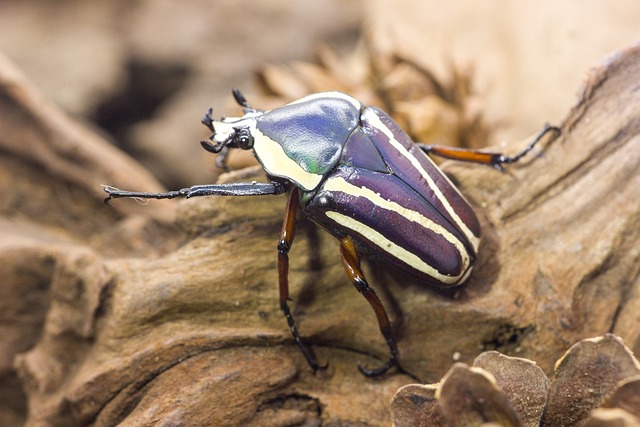Beetle infestations disrupt ecosystems and may result from human activities like urban expansion and deforestation. Traditional chemical controls cause further environmental damage and health risks. Eco-friendly solutions, including biological controls, habitat manipulation, and plant repellents, offer a sustainable approach to commercial beetle control that minimizes ecological impact and promotes biodiversity while adhering to regulations. These methods, such as neem oil and Bt, prioritize worker and community safety alongside effective infestation management. A multi-strategic, long-term approach combining monitoring, sanitation, biological controls, physical barriers, and education is key to successful eco-conscious beetle management.
In recent years, the demand for eco-friendly solutions has surged, especially in the realm of pest management. This shift is no less crucial when it comes to addressing beetle infestations, which can have devastating impacts on both ecosystems and businesses, particularly in commercial settings. Traditional methods often rely on toxic chemicals, raising environmental concerns. This article explores sustainable alternatives, delving into the understanding of beetle behavior, comparing traditional vs. eco-friendly control methods, and providing best practices for effective yet green commercial beetle control.
Understanding Beetle Infestations and Their Impact on the Environment
Beetle infestations can have a significant environmental impact, particularly in ecosystems already under strain. Commercial beetle control is often seen as a quick fix, but it’s important to understand that beetles play vital roles in natural cycles—as decomposers, predators, and prey—that maintain ecological balance. Infestations often result from disrupted habitats or imbalances in these delicate systems, which can be caused by human activities like urban expansion or deforestation.
When beetles invade, they can decimate plant life, disrupt food chains, and leave behind toxic residues that harm soil quality and water bodies. The impact ripples through the landscape, affecting not just local flora and fauna but also neighboring areas. Thus, effective eco-friendly solutions for beetle control are essential to protect both the environment and communities, offering a more sustainable approach to managing these infestations compared to traditional commercial methods.
Traditional vs. Eco-Friendly Beetle Control Methods
Traditional methods of commercial beetle control often rely on synthetic pesticides, which can have harmful effects on the environment and non-target organisms. These chemicals may persist in the soil, water bodies, and ecosystems, leading to long-term ecological imbalances. Moreover, they pose risks to human health, especially when not applied correctly or in high concentrations.
Eco-friendly solutions, on the other hand, offer a more sustainable approach to beetle control. These methods focus on minimizing environmental impact while effectively managing beetle populations. Strategies include biological controls like introducing natural predators or parasites, habitat manipulation, and the use of plant-based repellents or essential oils. Such eco-conscious tactics not only protect ecosystems but also ensure the safety of workers and nearby communities in commercial settings.
Implementing Green Solutions for Commercial Beetle Control
In the realm of commercial beetle control, adopting green solutions offers a sustainable and environmentally conscious approach to managing infestations. Instead of relying solely on chemical pesticides, businesses can implement eco-friendly methods that target specific species while minimising harm to non-target organisms, plants, and the overall ecosystem. Integrating natural predators, such as certain birds, bats, and insects, along with biological control agents, provides an effective yet gentle means of pest management.
Moreover, green solutions include the strategic use of plant-based repellents, beneficial fungi, and bacteria that can disrupt beetle life cycles. For instance, neem oil, derived from the neem tree, acts as a natural insecticide by inhibiting beetle growth and reproduction. Similarly, introducing beneficial microorganisms like Bacillus thuringiensis (Bt) can specifically target and eliminate beetle larvae without affecting other insects or the environment. These methods not only promote biodiversity but also contribute to creating a healthier and more sustainable work environment for employees while ensuring compliance with environmental regulations.
Benefits and Best Practices for Sustainable Beetle Management
In the pursuit of eco-friendly solutions, sustainable beetle management offers a harmonious balance between preserving the environment and mitigating pest issues. One of the primary benefits is minimizing the use of synthetic chemicals, reducing ecological impact and potential risks to non-target organisms, including beneficial insects and wildlife. Moreover, these methods promote biodiversity by fostering healthy ecosystems, which can naturally regulate beetle populations over time.
Best practices for sustainable commercial beetle control involve integrating multiple strategies. This includes regular monitoring and early detection systems to identify beetle presence. Cultural controls, such as proper sanitation and waste management, play a crucial role in prevention. Biological controls like introducing natural predators or parasites can effectively manage beetle infestations without harmful chemicals. Physical barriers and traps are also valuable tools, offering targeted and non-toxic solutions for specific areas. Additionally, educating property managers and businesses about the importance of sustainable practices ensures long-term success in eco-conscious beetle control.
In light of the above discussions, it’s clear that adopting eco-friendly solutions for commercial beetle control is both feasible and beneficial. By understanding beetle infestations’ environmental impact and embracing green methods, businesses can effectively manage these pests while minimizing harm to the ecosystem. The implementation of sustainable practices not only protects non-target organisms but also contributes to a healthier, more balanced environment. As we move forward, prioritizing green solutions in commercial settings will be crucial for long-term pest management and preserving our planet’s biodiversity.
